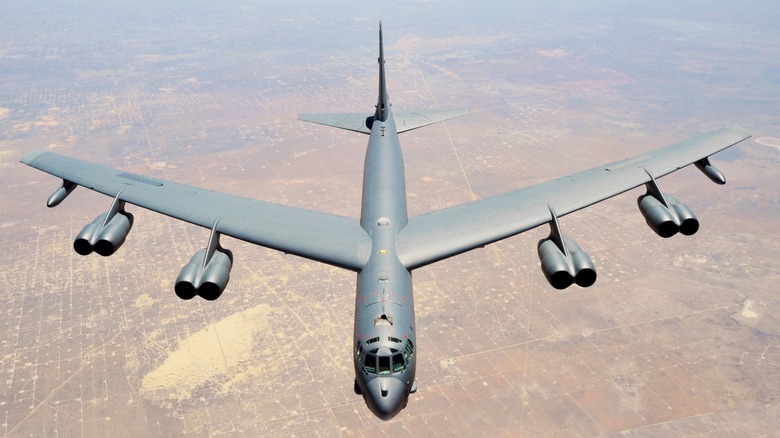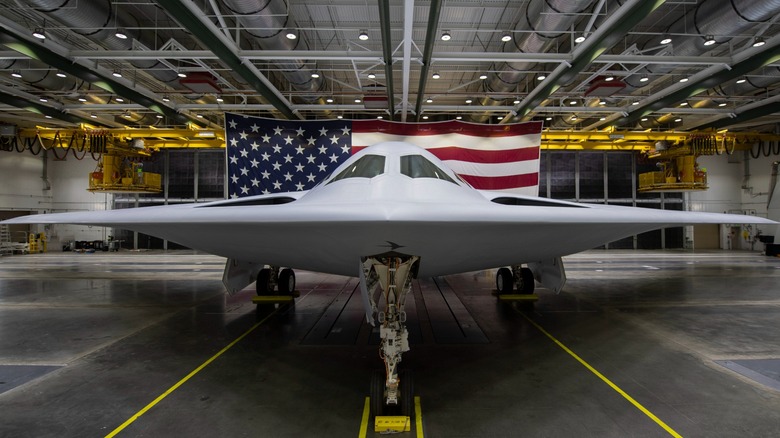How Many Bomber Planes Does The US Military Have?
The United States has been at the forefront of strategic bomber design for decades, and its fleet is considerably larger than that of other nations. All of the U.S. Air Force's strategic bombers are jet-powered, and they have incredible ranges; allowing for their deployment to any place on the planet, though distances in excess of around 6,000 miles require aerial refueling. As of 2025, the U.S. operates three types of strategic bombers: the B-52 Stratofortress (pictured), the B-1B Lancer, and the B-2 Spirit.
In addition to its fleet of 138 strategic bombers, aircraft traditionally thought of as fighters are more than capable of carrying bombs. Some examples include the F-22 Raptor and the F-35 Lightning II, which is the first U.S. stealth fighter capable of carrying nuclear bombs. If every aircraft capable of dropping bombs were lumped together, the U.S. would have a fleet so massive that it would overshadow every other nation on the planet. To simplify things, only strategic bombers are being lumped together.
While this significantly reduces the number of operational bombers, the remaining planes are more than adequate to support military operations worldwide. While the U.S. has three types of strategic bombers in its inventory, another is on the way: The B-21 Raider is set to replace the B-1, B-2, and eventually, the B-52. Once it takes to the skies, the B-21 will reign supreme throughout the world's airspace as the most advanced strategic bomber ever designed. Here's what the existing bomber fleet looks like.
The U.S. has a lot of bombers already
Of the three strategic bombers operated by the Air Force, the B-52 is easily the oldest, having been introduced in 1955. The current model is the B-52J, and the service is in the midst of upgrading its existing bombers to the new standards. These are outfitted with eight Rolls-Royce F-130 engines, and the first batch of 51 bombers will be upgraded by fiscal year (FY) 2032. The remaining 23 will be completed by the following year, bringing all 74 up to modern standards.
The B-1B (pictured) is the second-oldest bomber in operation, as it entered the inventory in 1974. Like the B-52, the B-1B has undergone numerous upgrades over the years. While 104 were built throughout the life of the program, the Air Force maintains a smaller fleet of 45 aircraft. While the B-52 is expected to retire sometime in the 2050s or beyond, the B-1B isn't as fortunate. The Air Force is preparing to retire its fleet by 2036. Until that time, they remain in operation, conducting various training missions and bomber tasks.
Finally, the B-2 Spirit, the Air Force's newest bomber and the only stealth-capable strategic bomber in its inventory, entered service in 1997. The initial plan was to procure 132, but this was slashed due to the incredible cost of a single B-2 of around $2 billion per plane when adjusted for inflation. Of the 21 produced, the Air Force continues to operate 19 B-2s. These are scheduled to be replaced by the B-21 in 2032.
The U.S. intends to develop many more bombers
The B-21 Raider has been in development since 2011, and it has a projected entry date sometime in the mid-2020s. As of 2025, three aircraft have been built for testing, and one was unveiled to the public in December 2022. Much of the lessons learned from producing the B-2 have gone into the creation of the B-21, which is significantly more advanced. That said, the costs per aircraft are considerably lower, as each one is expected to be around $814 billion per plane.
Unfortunately, Northrop Grumman (the contractor building the B-21) suffered a loss of $477 million tied to manufacturing costs. Initially, the Air Force aimed to acquire 100 B-21s. Since then, it appears that the Air Force is looking to increase its order to 145 aircraft; though these additional bombers could fall under a separate contract or be from an extension of the first. Regardless, the costs are high, but less than those of the B-21's predecessor. It won't be long before the Air Force fields the most advanced bombers ever designed, and in significant numbers.
Gen. Anthony J. Cotton, head of U.S. Strategic Command, not only indicated a desire to acquire a total of 145 B-21s, with 100 being the absolute minimum, but he mentioned that the total number of bombers the service would then have would be 220. Granted, as older bombers are phased out, that number will decrease, but as B-21s are entered into service, the U.S. bomber fleet will be massive.


